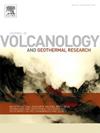Seismic imaging of mid-crustal heterogeneity beneath geothermal systems, central Taupō Volcanic Zone, New Zealand
IF 2.3
3区 地球科学
Q2 GEOSCIENCES, MULTIDISCIPLINARY
Journal of Volcanology and Geothermal Research
Pub Date : 2025-09-23
DOI:10.1016/j.jvolgeores.2025.108448
引用次数: 0
Abstract
The Taupō Volcanic Zone (TVZ) in New Zealand is a region of highly productive Quaternary volcanism and high hydrothermal heat flux. We investigate the mid-crustal seismic velocity structure of a region within the central, rhyolitic part of the TVZ encompassing high-temperature geothermal systems (e.g. Wairakei, Rotokawa). Using double-difference tomographic inversion of local earthquake data we derive 3-D models of P-wave velocity (Vp) and Vp/Vs for the subsurface. Both high ( 6.0 km/s) and low ( 5.5 km/s) Vp heterogeneities are seen in the mid-crust between 5 and 11 km depth. Regions with high Vp are interpreted to indicate the presence of solidified, more mafic, material within an otherwise quartzo-feldspathic crust, while regions with low Vp values are inferred to represent bodies of crystal-rich magma with a low melt fraction. Using the new 3-D velocity model we then relocated 9100 earthquakes recorded between 2009 and 2022. The relocated seismicity is strongly clustered, including in the vicinity of some of the geothermal systems (e.g. Rotokawa) where fluid is currently being extracted for electric-power production. Mid-crustal seismicity is also observed west of the Wairakei geothermal field, as well as along the south-eastern margin of the Ngakuru graben and on the western margin of the Whakamaru caldera. The depth distribution of the highest-quality hypocentres shows that 90% of the seismicity at Rotokawa geothermal field occurs at depths shallower than 5.1 km, consistent with a shallow brittle–ductile transition and the presence of a cooling pluton beneath Rotokawa seen in magnetotelluric data.
新西兰陶普火山带中部地热系统下中地壳非均质性的地震成像
新西兰陶普火山带(taupgi Volcanic Zone, TVZ)是一个第四纪火山活动高产和热液热通量高的地区。我们研究了包括高温地热系统(如Wairakei, Rotokawa)在内的TVZ中心流纹岩部分区域的中地壳地震速度结构。利用局部地震资料的双差层析反演,导出了地下纵波速度(Vp)和Vp/Vs的三维模型。高Vp (> 6.0 km/s)和低Vp (< 5.5 km/s)非均质性均见于5 ~ 11 km深度的中地壳。高Vp的区域被解释为在石英长石地壳中存在凝固的、更基性的物质,而低Vp的区域被推断为具有低熔融分数的富含晶体的岩浆体。利用新的三维速度模型,我们重新定位了2009年至2022年间记录的约9100次地震。重新定位的地震活动强烈聚集,包括在一些地热系统附近(例如Rotokawa),目前正在提取流体用于发电。在Wairakei地热田的西部,以及沿Ngakuru地堑的东南边缘和Whakamaru火山口的西部边缘,也观察到中地壳地震活动。高质量震源的深度分布表明,Rotokawa地热田90%的地震活动发生在浅于5.1 km的深度,这与大地电磁资料中Rotokawa地热田的浅脆性-韧性转变和冷却岩体的存在相一致。
本文章由计算机程序翻译,如有差异,请以英文原文为准。
求助全文
约1分钟内获得全文
求助全文
来源期刊
CiteScore
5.90
自引率
13.80%
发文量
183
审稿时长
19.7 weeks
期刊介绍:
An international research journal with focus on volcanic and geothermal processes and their impact on the environment and society.
Submission of papers covering the following aspects of volcanology and geothermal research are encouraged:
(1) Geological aspects of volcanic systems: volcano stratigraphy, structure and tectonic influence; eruptive history; evolution of volcanic landforms; eruption style and progress; dispersal patterns of lava and ash; analysis of real-time eruption observations.
(2) Geochemical and petrological aspects of volcanic rocks: magma genesis and evolution; crystallization; volatile compositions, solubility, and degassing; volcanic petrography and textural analysis.
(3) Hydrology, geochemistry and measurement of volcanic and hydrothermal fluids: volcanic gas emissions; fumaroles and springs; crater lakes; hydrothermal mineralization.
(4) Geophysical aspects of volcanic systems: physical properties of volcanic rocks and magmas; heat flow studies; volcano seismology, geodesy and remote sensing.
(5) Computational modeling and experimental simulation of magmatic and hydrothermal processes: eruption dynamics; magma transport and storage; plume dynamics and ash dispersal; lava flow dynamics; hydrothermal fluid flow; thermodynamics of aqueous fluids and melts.
(6) Volcano hazard and risk research: hazard zonation methodology, development of forecasting tools; assessment techniques for vulnerability and impact.

 求助内容:
求助内容: 应助结果提醒方式:
应助结果提醒方式:


